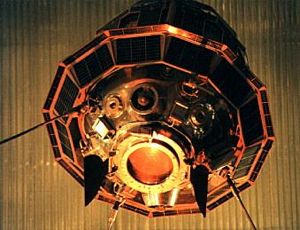
Home - Search - Browse - Alphabetic Index: 0- 1- 2- 3- 4- 5- 6- 7- 8- 9
A- B- C- D- E- F- G- H- I- J- K- L- M- N- O- P- Q- R- S- T- U- V- W- X- Y- Z
Luna E-3
 Luna 3 / E-3 Credit: © Mark Wade |
AKA: E-2A;E-3. Status: Operational 1959. First Launch: 1959-10-04. Last Launch: 1960-04-16. Number: 3 . Gross mass: 279 kg (615 lb).
The craft was a cylindrically shaped canister which was equipped with radio communication and telemetry systems, an imaging system with an automatic film processing unit, a set of scientific instruments, three solar cells for electric power supply, and a temperature control system.
It had gas jets for stabilization and photoelectric cells to maintain orientation with respect to the Sun and Moon. This spacecraft was controlled by radio command from Earth. It was launched on a figure-eight trajectory which brought it over the Moon (closest approach to the Moon was 6200 km) and around the far side, which was sunlit at the time. It was stabilized while in optical view of the far side of the Moon. The spacecraft returned very indistinct pictures, but, through computer enhancement, a tentative atlas of the lunar farside was produced. These first views of the lunar far side showed mountainous terrain, very different from the near side, and two dark regions which were named Mare Moscovrae (Sea of Moscow) and Mare Desiderii (Sea of Dreams).
More at: Luna E-3.
Family: Lunar Flyby, Moon. Country: Russia. Spacecraft: Luna E-3. Launch Vehicles: R-7, Vostok-L 8K72. Projects: Luna. Launch Sites: Baikonur, Baikonur LC1. Agency: Korolev bureau. Bibliography: 16, 175, 2, 296, 3840, 445, 6, 4801, 12772.
 | Luna Ye-3 Credit: Manufacturer Image |
1959 October 4 - . 00:43 GMT - . Launch Site: Baikonur. Launch Complex: Baikonur LC1. LV Family: R-7. Launch Vehicle: Vostok-L 8K72.
- Luna 3 - .
Payload: E-2A s/n 1. Mass: 279 kg (615 lb). Nation: Russia.
Agency: MVS.
Program: Luna.
Class: Moon.
Type: Lunar probe. Spacecraft: Luna E-3.
Decay Date: 1960-04-20 . USAF Sat Cat: 21 . COSPAR: 1959-Theta-1. Apogee: 499,998 km (310,683 mi). Perigee: 500 km (310 mi). Inclination: 55.00 deg. Period: 21,563.20 min.
Luna 3 was the third spacecraft successfully launched to the Moon and the first to return images of the lunar far side. It was launched on a figure-eight trajectory which brought it over the Moon (closest approach to the Moon was 6200 km) and around the far side, which was sunlit at the time. It was stabilized while in optical view of the far side of the Moon. On October 7, 1959, the television system obtained a series of 29 photographs over 40 minutes, covering 70% of the surface, that were developed on-board the spacecraft. The photographs were scanned and 17 were radio transmitted to ground stations in facsimile form on October 18, 1959, as the spacecraft, in a barycentric orbit, returned near the Earth. The photographs were to be retransmitted at another point close to Earth but were not received. The spacecraft returned very indistinct pictures, but, through computer enhancement, a tentative atlas of the lunar farside was produced. These first views of the lunar far side showed mountainous terrain, very different from the near side, and two dark regions which were named Mare Moscovrae (Sea of Moscow) and Mare Desiderii (Sea of Dreams).
1960 April 15 - . Launch Site: Baikonur. Launch Complex: Baikonur LC1. LV Family: R-7. Launch Vehicle: Vostok-L 8K72. FAILURE: The third stage RO-5 engine either did not reach full thrust or shut down early.. Failed Stage: 3.
- Luna failure - third stage insufficient delta V - . Payload: E-3 s/n 1. Mass: 279 kg (615 lb). Nation: Russia. Agency: RVSN. Program: Luna. Class: Moon. Type: Lunar probe. Spacecraft: Luna E-3. Decay Date: 1960-04-15 . COSPAR: F600415A. Reached an altitude of 200,000 km before plunging back to earth..
1960 April 16 - . 16:07 GMT - . Launch Site: Baikonur. Launch Complex: Baikonur LC1. LV Family: R-7. Launch Vehicle: Vostok-L 8K72. FAILURE: Strap-on B reached only 75 percent of thrust at ignition. Four tenths of a second after liftoff it broke away from the core.. Failed Stage: 2.
- Luna failure at lift-off - . Payload: E-3 s/n 2. Mass: 279 kg (615 lb). Nation: Russia. Agency: RVSN. Program: Luna. Class: Moon. Type: Lunar probe. Spacecraft: Luna E-3. Decay Date: 1960-04-16 . This dramatic failure resulted in a loss of thrust, and the lateral strap-on units separated and flew over the tracking stations and living areas. The core continued on its trajectory..
1962 October 22 - .
- Soviet lunar photographs analysed - .
Nation: USA.
Program: Apollo.
Spacecraft: Luna E-3.
The Lunar and Planetary Laboratory of the University of Arizona, directed by Gerard P. Kuiper, reported that its analysis of lunar photographs taken by Lunik III differed from that announced by Soviet scientists. The most extensive feature of the moon's far side, photographed in 1959, had been named "The Soviet Mountains"; this feature was identified by the Arizona laboratory as an elongated area of bright patches and rays, possibly flat. Another feature, named the "Joliot-Curie Crater" by Soviet scientists, was re-identified by the Arizona laboratory as Mare Novum (New Sea), first identified by German astronomer Julius Franz near the turn of the century.
Back to top of page
Home - Search - Browse - Alphabetic Index: 0- 1- 2- 3- 4- 5- 6- 7- 8- 9
A- B- C- D- E- F- G- H- I- J- K- L- M- N- O- P- Q- R- S- T- U- V- W- X- Y- Z
© 1997-2019 Mark Wade - Contact
© / Conditions for Use